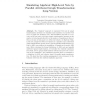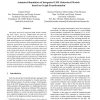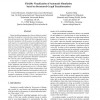101
click to vote
BIRTHDAY
2005
Springer
15 years 5 months ago
2005
Springer
The “classical” approach to represent Petri nets by graph transformation systems is to translate each transition of a specific Petri net to a graph rule (behavior rule). This ...
76
Voted
BIRTHDAY
2005
Springer
15 years 5 months ago
2005
Springer
Modularization is a well-known concept to structure software systems as well as their specifications. Modules are equipped with export and import interfaces and thus can be connec...
107
Voted
VL
2005
IEEE
15 years 6 months ago
2005
IEEE
In this paper we present a formal approach, based on meta-modelling and graph transformation, to the generation of environments for visual languages (VLs) supporting multiple view...
VL
2005
IEEE
15 years 6 months ago
2005
IEEE
This paper shows how integrated UML models combining class, object, use-case, collaboration and state diagrams can be animated in a domain-specific layout. The presented approach...
ACSD
2005
IEEE
15 years 6 months ago
2005
IEEE
This paper presents our approach to model distributed discrete event simulation systems in the framework of distributed graph transformation. We use distributed typed attributed g...
122
Voted
AGTIVE
2007
Springer
15 years 6 months ago
2007
Springer
Abstract. In this short paper we describe the setup and results of a new initiative to compare graph transformation tools, carried out as part of the AGTIVE 2007 symposium on “Ap...
105
click to vote
AGTIVE
2007
Springer
15 years 6 months ago
2007
Springer
Abstract. With graph pattern matching the field of graph transformation (GT) includes an NP-complete subtask. But for real-life applications it is essential that graph pattern mat...
123
click to vote
HICSS
2007
IEEE
15 years 6 months ago
2007
IEEE
This paper presents a graph transformation based approach to design pattern evolution. An evolution of a design pattern includes modifications of pattern elements, such as classes...
VL
2008
IEEE
15 years 6 months ago
2008
IEEE
Visual modeling languages for discrete behavior modeling allow the modeler to describe how systems develop over time during system runs. Models of these languages are the basis fo...
RELMICS
2009
Springer
15 years 6 months ago
2009
Springer
We define collagories essentially as “distributive allegories without zero morphisms”, and show that they are sufficient for accommodating the relation-algebraic approach to ...





